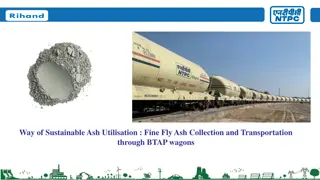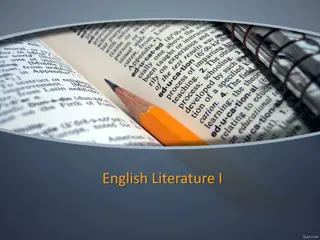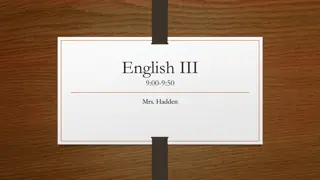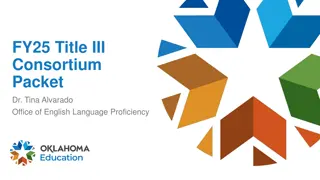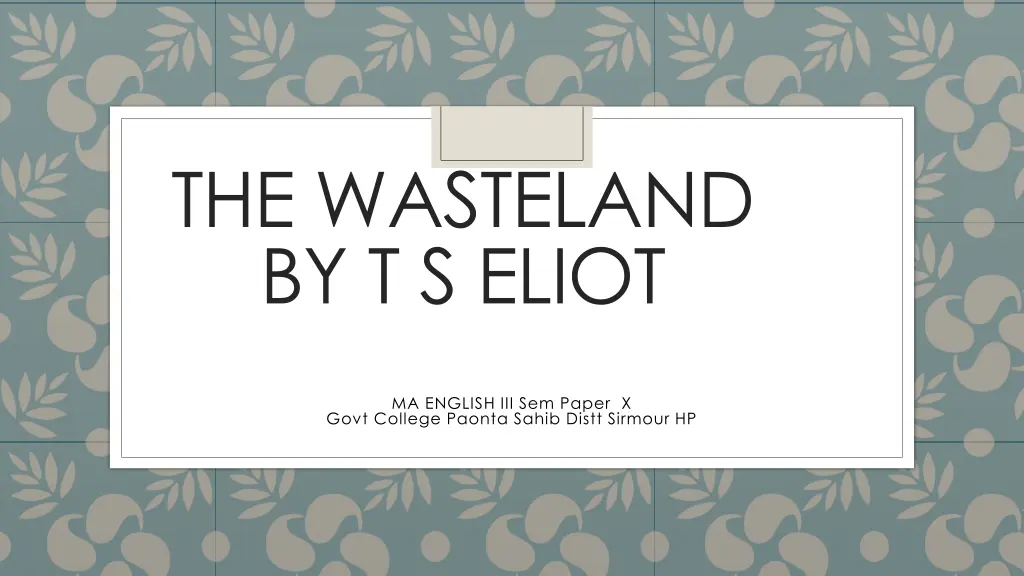
Themes and Structure of T.S. Eliot's The Wasteland
Explore the barrenness and redemption themes in T.S. Eliot's The Wasteland, a modernist poem featuring complex structures and Eastern influences. Learn about the poem's sections, language form, and symbolism, delving into the depths of societal decay and spiritual hope.
Download Presentation

Please find below an Image/Link to download the presentation.
The content on the website is provided AS IS for your information and personal use only. It may not be sold, licensed, or shared on other websites without obtaining consent from the author. If you encounter any issues during the download, it is possible that the publisher has removed the file from their server.
You are allowed to download the files provided on this website for personal or commercial use, subject to the condition that they are used lawfully. All files are the property of their respective owners.
The content on the website is provided AS IS for your information and personal use only. It may not be sold, licensed, or shared on other websites without obtaining consent from the author.
E N D
Presentation Transcript
THE WASTELAND BY T S ELIOT MA ENGLISH III Sem Paper X Govt College Paonta Sahib Distt Sirmour HP
Eastern religions and philosophies emphasize themes of barrenness and desolation and portrays a dying society the ending suggests hope of redemption through concepts and images grounded on the synthesis of Christian and Eastern (Hindu/Buddhist) spirituality
Language FormModernist poetry. Irregular verse, at times free, at times reminiscent of the blank verse of Eliots plays The poem was reduced to half the length of earlier drafts at Ezra Pound's suggestion Complex scholarly annotations to explain the many quotations and obscure allusions Five sections and features multiple voices and a deliberate attempt at creating a sense of fragmentation, discontinuity, and decay.
StructureEpigraph Five sections The Burial of the Dead A Game of Chess The Fire Sermon Death by Water What the Thunder Said
StructureEpigraph Five sections The Burial of the Dead A Game of Chess The Fire Sermon Death by Water What the Thunder Said
I. The Burial of the Dead (1/2)Four poems Line 1-18 Marie recalls her sledding and claims that she is German, not Russian. The woman mixes a meditation on the seasons with remarks on the barren state of her current existence. Line 19-42 A prophetic, apocalyptic invitation to journey into a desert waste, where the speaker will show the reader something different from either/ Your shadow at morning striding behind you/ Or your shadow at evening rising to meet you/ He will show you fear in a handful of dust.
The Burial of the Dead (2/2)Four poems Line 43-59 It describes an imaginative tarot reading, in which some of the cards Eliot includes in the reading are not part of an actual tarot deck. Line 60-76 The speaker walks through a London populated by ghosts of the dead. He confronts a figure with whom he once fought in a battle. The speaker asks the ghostly figure, Stetson, about the fate of a corpse planted in his garden.
A Game of ChessThis section focuses on two opposing scenes high society and the lower classes. Two poems Line 77-138 A wealthy, highly groomed woman surrounded by exquisite furnishings. Line 139-172 In a London barroom, where two women discuss a third woman.
III. The Fire Sermon (1/3)Taken from a sermon given by Buddha in which he encourages his followers to give up earthly passion and seek freedom from earthly things. Four poems Line 173-206 Line 207-214 Line 215-265 Line 266-311
The Fire Sermon (2/3)The section opens with a desolate riverside scene Rats and garbage surround. The speaker, who is fishing and musing on the king my brother's wreck. The speaker is then propositioned by Mr. Eugenides, the one-eyed merchant of Madame Sosostris's tarot pack.
III. The Fire Sermon (3/3)The speaker then proclaims himself to be Tiresias, a figure from classical mythology who has both male and female features and is blind but can see into the future. Tiresias/the speaker observes a young typist, at home for tea, who awaits her lover, a dull and slightly arrogant clerk. The woman allows the clerk to have his way with her, and he leaves victorious. Tiresias, who has foresuffered all, watches the whole thing. After her lover's departure, the typist thinks only that she's glad the encounter is done and over.
IV. Death by WaterThe shortest section of the poem. Describes a man, Phlebas the Phoenician, who has died by drowning. In death he has forgotten his worldly cares as the creatures of the sea have picked his body apart.
What the Thunder Said (1/2)One poem line 322-423 Builds to an apocalyptic climax, as suffering people become "hooded hordes swarming" and the "unreal" cities of Jerusalem, Athens, Alexandria, Vienna, and London are destroyed, rebuilt, and destroyed again. The scene then shifts to the Ganges, half a world away from Europe, where thunder rumbles.
What the Thunder Said (2/2)Finale line 424-434 Ends with a series of disparate fragments from a children's song, from Dante, and from Elizabethan drama, leading up to a final chant of Shantih shantih shantih.
Epigraphto express the subject Sibyl in the Satyricon (myth) , a woman with prophetic power and long life, grows old, but cannot die. She is yearning to die. The Sibyl's condition suggests Eliot lives in a culture that has decayed and withered but will not end.
Techniques in TextDramatic monologue (L818, L2530) Allusions to the Bible (L20), plays (The Tempest, The Devils Law Case), and myths (The Fisher King, Inferno) Fragmentary formsEx. broken image (L22)(L428-30) Symbols of water, hyacinth, the Tarot pack of cards, the drowned Phoenician Sailor, the Hanged God. Compare and Contrast---Mylae War is compared to the World War I. QuotationsParadise Lost9 (IV, 140), The Devils Law Case (III,ii,162), The White Devil (V,6, 203-205), Confession punjug (L103)
I. The Burial of the DeadTheme Inhabitants in the Waste Land live a hopeless life. People can usually obtain salvation (rebirth) from the burial of the dead, but inhabitants in the Waste Land are afraid of rebirth. 18 II. A Game of ChessTheme The community's impotence and degradation, sex
III. The Fire SermonTheme Eliot uses St. Augustine and Buddhas thoughts to teach man to keep away from decay. 20 IV. Death by WaterTheme There will be no revival or resurrection after the Phoenicians death. Misunderstanding of greed and values have buried human beings deeper as a whole into the whirlpool.
V. What the Thunder SaidTheme The thunder said human beings could be saved through three verbs--give, sympathize, and control.
Analysis (1/2)Eliot uses A modern myth that world moving toward crisis and chaos Multiple narrators to see from different angles Dramatic monologue to convey the characters stream of unconsciousness and psychological condition. Fragmentation fragmentation of modern life, lack of integration in the modern experience







